Все про видеонаблюдение
Все про умный дом
Все о пожарной безопасности
Сейчас читают
 Как ускорить и смотреть ютуб без тормозов и замедленияЕсли Вы на этой странице, то Вам, скорее всего, […]
Как ускорить и смотреть ютуб без тормозов и замедленияЕсли Вы на этой странице, то Вам, скорее всего, […] 10 лучших прогрессивных языков программирования для разработки мобильных приложенийЗнаете ли вы, что мобильные приложения — это не только […]
10 лучших прогрессивных языков программирования для разработки мобильных приложенийЗнаете ли вы, что мобильные приложения — это не только […] 6 важных особенностей, которые следует учитывать при строительстве нового домаСтроительство нового дома – это уникальная возможность […]
6 важных особенностей, которые следует учитывать при строительстве нового домаСтроительство нового дома – это уникальная возможность […]
Гороскоп на Сегодня
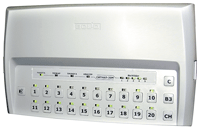
#control panels, #alarm
Control panels or PPK for short for store security alarm systems.
Currently, there are a huge number of devices used in retail establishments.
In order to somehow classify all their diversity in the article offered to your attention, all retail establishments can be conditionally divided into 3 categories.
The first is small (but numerous) stores with an area of approximately 300–500 sq. m. These facilities are fully owned by one owner and have one operating mode.
From the point of view of the control panel, this means one section, which is simultaneously armed and disarmed.
The second category is shopping centers.
Their peculiarity is a large number of individual stores, owned by different owners and having different operating modes.
Accordingly, the control panel must be able to arm and disarm each store separately.
Often in such a center one tenant dominates, occupying from 30% to 90% of the area, and the rest are just small accompanying shops that are not armed individually, then this object rather belongs to the third category.
The third category — hypermarkets with an area of 5,000 sq. m and above.
The term PPK (receiving and control device) is not quite appropriate here, as such facilities usually require an integrated system that includes access control and everything else.
Of course, the classification is conditional.
In particular, it does not include large single stores that are not yet hypermarkets, but do not fall under the criterion of «one operating mode».
Car showrooms, expensive equipment stores and boutiques have their own peculiarities, where tens of thousands of dollars of very delicate goods are located on one square meter.
However, from the point of view of the PPC, all of them rather belong to the third category, because the high cost of the goods allows the facility to be equipped with complex systems, essentially custom tailoring.
On the other hand, even at the largest facilities, individual sectors and individual stores can often be considered as independent small facilities of the first or second category.
In general, designing systems for really large facilities is a bit of an art, the most unusual solutions are possible, so we will not consider them in this article.
So, what are the main requirements for the control panel for retail facilities of the first (initial) category — one owner, one operating mode for all premises.
It is clear that the price is the dominant parameter. Of course, the price for the system. At small sites, the owner himself carefully delves into the proposals, and therefore it is pointless to offer a cheap control panel with expensive detectors, or vice versa.
A businessman will always find a «total» line that includes the cost of installation. At the same time, it is essential that one system should cover all needs, including mandatory fire alarm and a mandatory contract with non-departmental security for some types of goods.
At the same time, the system must be easy to operate, since it will be cleaners or salespeople of unpredictable technical qualifications who will arm and disarm it.
Two types of systems are used for such objects:
First – apartment system versions, usually of imported origin.
These are primarily the Vista series and similar products from DSC, Paradox, Visonic and many, many others.
Of course, if the system is set up for protection by «non-departmental entities», then among them only Vista produced by MZEP can be seriously considered (as a system included in the infamous «List»).
Domestic systems aimed at this segment are, as a rule, much easier to use.
No keyboards, remote controls, codes — setting the alarm with a button or a «touch memory» tablet.
In addition, as a rule, the minimum number of loops is one fire and one or maximum two security. But many such products immediately have built-in modules for communication with the CMS (centralized monitoring station), corresponding to the protocols adopted by non-departmental security (such as «Atlas»), or GSM modules popular in rural areas.
All such simple systems are monoblock: in one case there is a power supply with a battery, and circuits for monitoring the detector loops, and controls.
Some systems allow you to add remote status indicators and remote controls.
Since the number of loops is minimal, the indicators are very simple — a lamp that displays the system status by its state.
As a rule, it lights up — it means the alarm is on, it blinks — it means an alarm, etc.
The controls are also primitive: a button to arm or a touch memory contactor for the same purpose. This price range obviously does not include any LCD remote controls, control keyboards, etc.
But the communication modules with the central monitoring station may well be external, since when changing the security company, it may be necessary to change the communication protocol with the central monitoring station. In order not to change the entire system in such cases, an external module is installed immediately.
The second category of objects, the main distinguishing feature of which is the presence of many owners and many sections, each working according to its own schedule, are obviously equipped with multi-loop control panels capable of either organizing many sections or individually arming/disarming individual loops.
Such facilities usually have 24-hour security, so the entire alarm is output to the control panel in the security room, and only a consolidated signal (usually from a manual panic button) is output to a remote PCS.
As a rule, arming and disarming is done simultaneously with a note in the paper log of transfer to arming, therefore the delineation of powers at the control panel level is not essential.
Actually, arming is often done by the guard on duty, and even today the option of arming the selected loop with the corresponding toggle switch (button) is quite acceptable.
Accordingly, the applied control panels can be divided into two types — with a remote control and, conventionally speaking, «with toggle switches».
In the first type of control panel, each section is indicated by number, in the second type of control panel, each section corresponds to a separate button or toggle switch.
The disadvantages and advantages of each type are quite obvious.
A remote control with an LCD display and a digital keyboard allows for a fairly arbitrary expansion of the system, usually up to 100 or even 1000 sections.
However, section numbers have to be remembered; rare systems allow you to specify clear text names, and also provide convenient means of searching for the desired section (selecting a section in a list of 200 lines is not the easiest task).
Systems «with toggle switches» are convenient and visual, but with a large number of sections they are somewhat cumbersome.
I have encountered a system in a shopping center consisting of seven control panels lined up in a row, but this case is more likely to be perceived as a joke, if only because the decision to bring almost 200 loops into one room is not the best from the point of view of ease of installation and maintenance.
In gradually growing facilities, control panels «with toggle switches» are often used first, and later, as the system grows, a remote control is added to them.
In reality, such situations with a gradual increase in the size of the system are rare, they are mainly used for reasons of «backup». How this remote control works is still unclear, and the buttons on each individual control panel will certainly work.
All systems date back to the last millennium (meaning they were developed 10 years ago).
Have there really been no new trends in recent years?
Perhaps the only thing that has changed is that addressable systems are gradually becoming more popular.
If in the 90s of the last century they were considered too expensive for use in budget cases, now, taking into account the savings on installation, both fire and even security addressable systems are often used. Fire addressable systems are more popular, because according to fire regulations in such cases it is often possible to use a smaller number of detectors.
Another trend that penetrates from really large systems is decentralization of control.
Imported systems always implied the possibility for each owner of each section to independently arm and disarm their section. In our case, the tactics of security actions usually implied a mandatory note in a paper log, and, therefore, there was no need to implement the possibility of control from several points. This was reflected in the equipment developed by our manufacturers for our security guards.
Only in really large systems (for example, nuclear power plants) has it always been necessary to set the section for protection directly from inside or near the section territory, because the road to the checkpoint can take about an hour, and you can't leave the premises unprotected all this time.
Recently, all systems that were previously centralized have acquired some means of decentralization, the ability to add separate consoles at least for setting/removing protection.
Finally, one trend can be traced not so much in the equipment produced, but in the methodology for its use.
If earlier, for reasons of economy, several rooms were sometimes connected to one non-addressable loop, now (at least, this was the case in 2008) they strive to identify the control point as much as possible.
In addition to the greater information content of the system, this also simplifies its maintenance — individual identification of a faulty device saves a lot of time and effort.
DSC (Tyco) control panels
DSC control panels have a huge number of useful functions. The presence of a built-in communicator and several sections allows using one control panel for centralized protection of several objects located in one building.
The popular Power line of control panels allows you to build systems with up to 64 wired zones and use up to 32 wireless detectors, which is ideal for small and medium-sized facilities. The MAXSYS series of control panels are designed for large facilities and additionally allow you to use graphic displays to display alarms on room plans.
To quickly equip a facility with an alarm system, you can use a completely wireless system.
The control panel, control panel and receiver are made in one case, but in terms of functionality, such a system is not inferior to the Power line of panels.
INTEGRA-128 WRL control panel for large retail chains (SATEL)
The Integra-128 WRL control panel (CP) from the Polish company Satel is part of the Integra series of panels and is designed to create fire alarm systems for large shopping centers, offices and enterprises.
This CP differs from earlier models and analogues in its additional capabilities in the field of wireless communications.
Thanks to the GSM/GPRS module built into the control panel, the fire alarm system can be configured and controlled from a mobile phone, and for interaction with wireless devices of the ABAX system, a transceiver operating in the 868.0-868.6 MHz frequency band is installed on the Integra-128 WRL board.
In addition, this control panel can have 128 programmable outputs and control up to 128 zones combined into 32 groups.
The device supports various types of loops (NO, NC, EOL, 2EOL) and performs ACS functions.
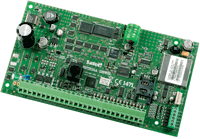
By adding the TCP/IP ETHM-1 or ETHM-2 module to the alarm system, you can remotely access the fire alarm system via a web browser or a mobile phone with a Java application installed.
Thanks to this solution, the fire alarm system can be controlled from anywhere in the city, country or world.
The control panel is configured using the DloadX program, which runs in Windows 98/ME/2000/XP.
To do this, DloadX is installed on a computer connected to the Integra-128WRL panel via the RS-232 port or via a telephone line and modem.
The receiving and control device for fire and security alarm control panel «Spectrum-8» («Argus-Spectrum»)
It is intended for autonomous and centralized protection of objects of varying complexity: from small shops to hypermarkets and shopping malls.
The modular design principle allows you to select an individual configuration for each object and easily add any blocks as needed.
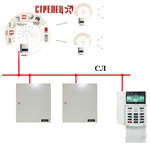
The number of alarm loops controlled by one control and receiving module is 8 or 24. When combining modules into a system — up to 512.
«Spectr-8» works with various notification transmission systems:
dial-up telephone lines (Contact ID);
GSM (text SMS messages, Data CSD);
busy telephone lines (Atlas-20);
radio channel (Argon).
Integration with the wireless STRELETS® fire alarm system, Kronverk ACS, Accord-512 control panel and other equipment from Argus-Spectr at the software and hardware level.
Programming and control of the Spectr-8 control panel is carried out using a control panel with an LCD display or a computer.
Also, for ease of control of the device, it is possible to connect additional control panels (LCD or with LED indication), TM keys and Proximity cards.
The Signal-20M (Bolid) security and fire alarm control and monitoring device
It is designed for autonomous operation, as well as operation as part of the Orion ISO. The device has 20 alarm loops with all types of detectors.

Programming of alarm loop types:
— dual-threshold smoke fire
— dual-threshold combined fire
— dual-threshold heat fire
— security
— security with detector blocking contact monitoring
— entry security
— alarm
— technological
— programmable technological
The loops are controlled by a user password (up to 64 passwords), it is possible to control the loops and output relays of the device via the RS-485 interface.
The device is equipped with a built-in sound alarm, a housing opening sensor. There are also two built-in retractable panels for user inscriptions.
Supply voltage — from 10.2 to 28 V. Current consumed by the device in standby mode: with a power supply of 24 V — from 200 mA to 400 mA; with a power supply of 12 V — from 300 mA to 600 mA. Overall dimensions — 247 x 150 x 48 mm.
The SA-10 control panel for medium-sized stores (SATEL)
The SA-10 control panel (CP) from the Polish company Satel is designed to create fire alarm systems at such facilities as stores, offices, warehouses, etc.
The SA-10 can control up to 16 zones and supports the division of peripheral devices of the system into 4 independent groups.
To connect security equipment, the SA-10 is equipped with 6 programmable outputs, and to transmit messages to the monitoring station via a telephone line, the device has an autodialer system.
The SA-10 control panel has the ability to locally and remotely program the device from a computer, and LED and LCD keyboards are used to control the fire alarm system.
The device is powered by a pulse power supply with overload and short circuit protection.
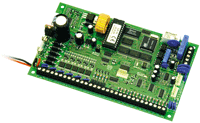
The SA-10 control panel allows programming various types of reactions to alarm events for the fire alarm zones.
In addition, for each logical loop, you can set the longest duration of a violation (in seconds) or its absence (in hours), after which the loop will be perceived by the control panel as faulty.
When transmitting messages over a telephone line, you can assign up to 9 event codes for each zone.
Four programmable outputs of the SA-10 are power outputs, rated for a current of 2.2 A, and two outputs are low-current, rated for a current of up to 50 mA.
Power outputs in the active state provide a voltage of 12 V to the security devices connected to them, and low-current outputs control the equipment using a relay.
VERS-PK2/4/8-02-TRIO (VERS MPP) autodialing system
VERS-PK2/4/8-02-TRIO is designed to protect facilities and implement prompt and low-cost measures to ensure fire alarm and automatic transmission of fire messages indicating the specific location of the fire to the Emergencies Ministry console (fire department) at facilities of social significance.
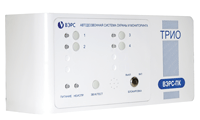
The system ensures protection of facilities from unauthorized entry, fire alarm, as well as prompt automatic notification of alarm events in the form of voice and SMS messages to pre-selected phone numbers (up to 22 numbers) of wired and cellular networks (GSM).
The device is based on the serially produced «MPP VERS» PPKOP VERS-PK2/4/8 series 02 with a built-in autodialer module, has advanced capabilities for flexible programming of parameters.
There are three user relays, the ability to control via a communication channel (information request, control of the alarm loop, relay), installation of a microphone on the site, control of TM keys.






Добавить комментарий